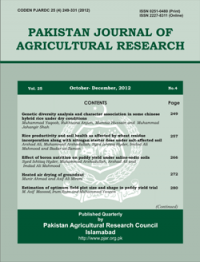BIODIVERSITY AND PHYTOSOCIOLOGICAL STUDIES OF UPSTREAM AND DOWNSTREAM RIPARIAN AREAS OF PAKISTAN: SPECIAL REFERENCE TO TAUNSA WILDLIFE SANCTUARY AND KETI SHAH FORESTS
Raja Zoq-ul-Arfeen*, Aamir Saleem*, Sarwat Naz Mirza*, Muhammad Akmal**, Hafiz Muhammad Tayyab* and Obaid Afzal***
ABSTRACT
Pakistan riparian zone mostly belongs to Sindh and Punjab provinces and prone to climatic problems and anthropogenic activities. The research was conduct to estimate and compare the structure and composition of riverine floral diversity in low riparian zone of River Indus. The data was collected from Keti Shah forest and Taunsa wildlife sanctuary. Total 14259 plants/individuals were recorded, which belong to 54 plant species with 18 different families. In Taunsa pre-monsoon survey, total 30 plant species were found with 4476 plants from 16 different families. In Taunsa post-monsoon survey total 3348 individuals were recorded from 20 plant species and 9 families. Similarly, in Keti Shah forest, total 3975 individual were recorded from 22 species and 11 families during the pre-monsoon season and 2460 plants were recorded in post-monsoon season, belonging to 16 species and 10 families. These species mostly belong to Fabaceae, Poaceae, Cyperaceae and Asclepiadaceae. Different phytosociological parameters indicate Tamarix dioca, Cynodon dactylon, Desmostachya bipinnata, Imperata cylindrica, Fimbristylis hispidula, Acacia nilotica, Phragmites karka, Tamarix sp. and Saccharum bengalense as dominant species. The biodiversity in upstream and downstream areas were rich in pre-monsoon season in comparison to post-monsoon season in surveyed areas. This study is useful for management of the area in the future as conservation strategies can be made through considering the adaptive tree species in future plantation and endangered species can be conserved.
To share on other social networks, click on any share button. What are these?







